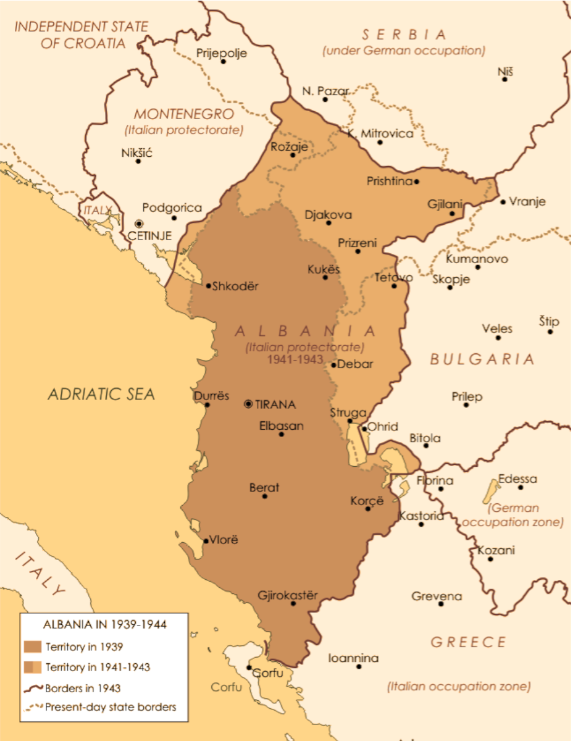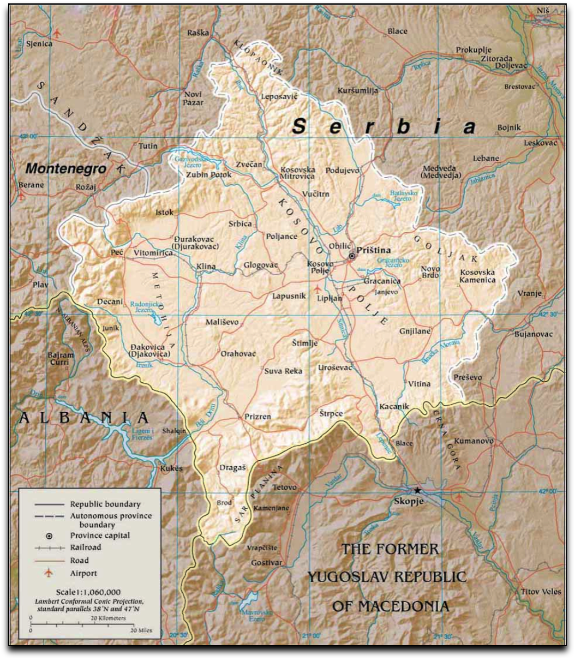Kosovo 1941 - 1944
In the 1930s about 400 Jews lived in Pristina, and 113 more lived in Kosovska Mitrovica; a few lived in Prizren. As Jewish refugees from Germany and Poland arrived in Kosovo, hoping to reach the sea and find their way to Palestine, the Pristina Jewish community greatly increased in numbers.
In 1940 Mussolini invaded Greece, with Italian and Albanian forces. A small sector of the front was under Albanian command. The Albanian forces included Albanians exiled from the Chameria or Epirus region of Greece. Mussolini and Hitler invaded Yugoslavia on April 6, 1941. Pristina came under German occupation in April and May 1941, and hundreds of refugees were rounded up and disappeared. Then the Germans withdrew, and the Italian Army took its place.
Most of Kosovo was then incorporated into Albania, an autonomous polity, ruled from Tirana by a regime which recognized the King of Italy as its sovereign. While its legal status was similar to that of Canada--an independent state recognizing the King of England as head of state--in view of Rome's control over Albanian foreign policy, Albania was an Italian protectorate.
Mussolini obtained the support of Albanian minorities in Yugoslavia by giving to Albania most territories claimed for Greater Albania: most of Kosovo, parts of Serbian Sandzak, parts of Montenegro, and parts of Macedonia, from Struga on Lake Ohrid to Tetovo. This assured to Mussolini a loyal and grateful regime in Tirana, which now had de iure control of most Albanian-populated parts of Yugoslavia, and de facto control of Albanian-populated parts of Greece. Such loyalty became indispensable to the Italians, as partisan warfare developed in Albania and in neighboring Montenegro and Greece.
In the 1930s about 400 Jews lived in Pristina, and 113 more lived in Kosovska Mitrovica; a few lived in Prizren. As Jewish refugees from Germany and Poland arrived in Kosovo, hoping to reach the sea and find their way to Palestine, the Pristina Jewish community greatly increased in numbers.
In 1940 Mussolini invaded Greece, with Italian and Albanian forces. A small sector of the front was under Albanian command. The Albanian forces included Albanians exiled from the Chameria or Epirus region of Greece. Mussolini and Hitler invaded Yugoslavia on April 6, 1941. Pristina came under German occupation in April and May 1941, and hundreds of refugees were rounded up and disappeared. Then the Germans withdrew, and the Italian Army took its place.
Most of Kosovo was then incorporated into Albania, an autonomous polity, ruled from Tirana by a regime which recognized the King of Italy as its sovereign. While its legal status was similar to that of Canada--an independent state recognizing the King of England as head of state--in view of Rome's control over Albanian foreign policy, Albania was an Italian protectorate.
Mussolini obtained the support of Albanian minorities in Yugoslavia by giving to Albania most territories claimed for Greater Albania: most of Kosovo, parts of Serbian Sandzak, parts of Montenegro, and parts of Macedonia, from Struga on Lake Ohrid to Tetovo. This assured to Mussolini a loyal and grateful regime in Tirana, which now had de iure control of most Albanian-populated parts of Yugoslavia, and de facto control of Albanian-populated parts of Greece. Such loyalty became indispensable to the Italians, as partisan warfare developed in Albania and in neighboring Montenegro and Greece.
Northern Kosovo and Mitrovica remained under German military occupation. In August 1941, all Jewish men in Kosovska Mitrovica were arrested, while the women were sent to daily forced labor, such as cleaning the streets. In February 1942, the women were also detained, with their children. In March 1942, all of the detained Jews were sent to Sajmiste, a concentration camp in Zemun, near Belgrade. Out of 113 Jews who lived in Kosovska Mitrovica, 25 survived, having escaped to the Italian occupation zone.
Hating Jews was not popular amongst Italians, but the Italian Army needed to secure the gratitude of its Albanian allies, who were allowed to profit by taking over Jewish properties. Albanian police had authority over the Jewish community, and the Italians tolerated the initiatives of Albanian police and militias, who arrested, humiliated, and robbed the Jews.
However, when it came to delivering Jews to the Germans, Italian Army officers ignored direct orders from Rome to collaborate with the Nazis over the "final solution of the Jewish Problem." Notwithstanding German diplomatic protests in Rome, the Italian Army gave protection to Jews in all Italian-occupied territories in Europe. In an exception, on March 14, 1942, Italian carabinieri (military police) detained 51 Jewish refugees in Pristina and delivered them to the Germans. They were sent to Sajmiste, where they were killed.
In 1942, Jewish men in Pristina were sent to a camp in Berat, Albania. Several Jewish families from Pristina were also interned in Albania, and were able to escape into the mountains where they hid until liberation, allowed to live in Albanian farmers' homes or barns. A few Jews were captured and disappeared, some joined the partisans, some were killed in combat. In this way, the great majority of Jews in Albania, as opposed to Greater Albania, survived the Holocaust.
After the collapse of the Italian Army in September 1943, Italian-supported Albanian police and militias came under German influence. in Albania, in Kosovo, and in the Italian former zones of occupation in Greece and Macedonia, said police and militias participated in anti-partisan warfare atrocities and in the roundup of Jews.
In 1944, recruiting Albanians volunteers from Kosovo, Macedonia, and Sandzak, the 21st Waffen SS Division Skanderbeg (21. Waffen-Gebirgs Division der SS Skanderbeg) was organized, under the command of German officers. In one of its successful operations, during the night of May 14, 1944, men of the SS Skanderbeg Division rounded up Pristina's Jews, mostly old men, women, and children. They were all taken to Sajmiste. In June 1944 they were all transported to Bergen-Belsen. This was a concentration camp, not an extermination camp, and the survival rate was relatively high, as opposed to that of prisoners sent to Auschwitz.
Our objectives
We want to keep alive the memory of Jewish victims of Nazi terror in Kosovo. They have the right to be honored and remembered. They paid the highest price for human liberty.
Every new generation has the obligation to know what has happened during WWII, and to preserve the historical truth and the dignity of all Holocaust victims.
This site has been made with much help from The Jewish Historical Museum in Belgrade.
Hating Jews was not popular amongst Italians, but the Italian Army needed to secure the gratitude of its Albanian allies, who were allowed to profit by taking over Jewish properties. Albanian police had authority over the Jewish community, and the Italians tolerated the initiatives of Albanian police and militias, who arrested, humiliated, and robbed the Jews.
However, when it came to delivering Jews to the Germans, Italian Army officers ignored direct orders from Rome to collaborate with the Nazis over the "final solution of the Jewish Problem." Notwithstanding German diplomatic protests in Rome, the Italian Army gave protection to Jews in all Italian-occupied territories in Europe. In an exception, on March 14, 1942, Italian carabinieri (military police) detained 51 Jewish refugees in Pristina and delivered them to the Germans. They were sent to Sajmiste, where they were killed.
In 1942, Jewish men in Pristina were sent to a camp in Berat, Albania. Several Jewish families from Pristina were also interned in Albania, and were able to escape into the mountains where they hid until liberation, allowed to live in Albanian farmers' homes or barns. A few Jews were captured and disappeared, some joined the partisans, some were killed in combat. In this way, the great majority of Jews in Albania, as opposed to Greater Albania, survived the Holocaust.
After the collapse of the Italian Army in September 1943, Italian-supported Albanian police and militias came under German influence. in Albania, in Kosovo, and in the Italian former zones of occupation in Greece and Macedonia, said police and militias participated in anti-partisan warfare atrocities and in the roundup of Jews.
In 1944, recruiting Albanians volunteers from Kosovo, Macedonia, and Sandzak, the 21st Waffen SS Division Skanderbeg (21. Waffen-Gebirgs Division der SS Skanderbeg) was organized, under the command of German officers. In one of its successful operations, during the night of May 14, 1944, men of the SS Skanderbeg Division rounded up Pristina's Jews, mostly old men, women, and children. They were all taken to Sajmiste. In June 1944 they were all transported to Bergen-Belsen. This was a concentration camp, not an extermination camp, and the survival rate was relatively high, as opposed to that of prisoners sent to Auschwitz.
Our objectives
We want to keep alive the memory of Jewish victims of Nazi terror in Kosovo. They have the right to be honored and remembered. They paid the highest price for human liberty.
Every new generation has the obligation to know what has happened during WWII, and to preserve the historical truth and the dignity of all Holocaust victims.
This site has been made with much help from The Jewish Historical Museum in Belgrade.


